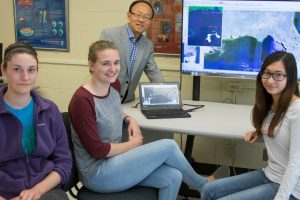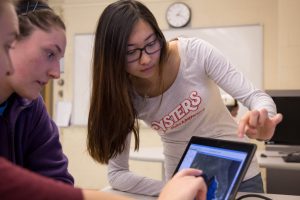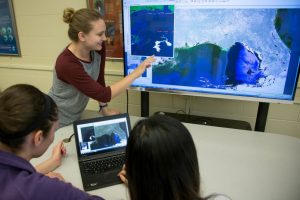Study Introduces Computer Science Students to Problem Solving Using Deepwater Horizon Imagery
– OCTOBER 11, 2016
University professors developed a team-based educational project using satellite images of Deepwater Horizon surface slicks to introduce first-year computer science students to socially-relevant problem solving. The professors guided students in designing and applying an algorithm to address an open-ended problem of outlining oil contaminated areas. The project’s use of realistic scenarios highlighted the societal contributions of computing careers. The developers published their project in the IEEE Frontiers in Education Conference Proceedings: Real-world problem solving in entry-level programming courses: A case study on the Deepwater Horizon oil spill.
The multi-phase project tasked students to design an image processing algorithm and implement computer software for analyzing surface slicks and outlining oiled areas. Phase one introduced students to “breaking news” on the Deepwater Horizon oil spill and the problem of mapping oil slicks on satellite images. Students developed a user-interface Java program to visualize ocean color satellite images. Phase two moved forward toward a solution by students suggesting and trying out software functions that distinguish oil from water. Phase three had students using data analysis to create scatter plots and develop linear functions to separate oil pixels. Then students implemented a thresholding algorithm with decision-making and repetition statements to outline oil slicks and evaluate results.
“Computer technologies are widely used in solving real-world problems. However, those problems are seldom used in teaching introductory-level computer science and engineering courses,” explained study author Mingrui Zhang. The developers expect to continue and strengthen this type of project for beginning computer science students in the coming years.
The IEEE Education Society disseminated the project Image Processing Algorithms for Identifying the Gulf Oil Spill to different universities around the world, which computer science general education and digital image processing classes have adapted. Most students who took the class said the project was a stimulating and intellectually challenging activity that increased their interest in problem-solving with computers.
The study’s authors are Mingrui Zhang, Chuanmin Hu, and Guleng Amu.
***********
This research was made possible in part by a grant from the Gulf of Mexico Research Initiative (GoMRI) to the Center for the Integrated Modeling and Analysis of Gulf Ecosystems II (C-IMAGE II). Other funding sources included the IEEE Real World Engineering Projects program and the National Aeronautics and Space Administration (NASA).
The Gulf of Mexico Research Initiative (GoMRI) is a 10-year independent research program established to study the effect, and the potential associated impact, of hydrocarbon releases on the environment and public health, as well as to develop improved spill mitigation, oil detection, characterization and remediation technologies. An independent and academic 20-member Research Board makes the funding and research direction decisions to ensure the intellectual quality, effectiveness and academic independence of the GoMRI research. All research data, findings and publications will be made publicly available. The program was established through a $500 million financial commitment from BP. For more information, visit https://gulfresearchinitiative.org/.
© Copyright 2010-2017 Gulf of Mexico Research Initiative (GoMRI) – All Rights Reserved. Redistribution is encouraged with acknowledgement to the Gulf of Mexico Research Initiative (GoMRI). Please credit images and/or videos as done in each article. Questions? Contact web-content editor Nilde “Maggie” Dannreuther, Northern Gulf Institute, Mississippi State University (maggied@ngi.msstate.edu).








